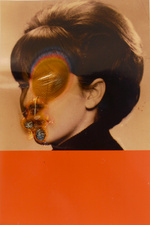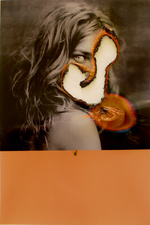‘Claude Cahun, born Lucy Renee Mathilde Schwob, was a French lesbian photographer, sculptor and writer. Schwob adopted the pseudonym Claude Cahun in 1917 and is best known for self-portraits, in which Cahun assumed a variety of personae.’ As a gender neutral person, Claude created many artworks starting at 20 years old, up to her death in her 50’s. She used this artwork to express her identity- this being mostly gender identity. I would describe her work as fascinating and odd with a sense of deep meaning yet a bit of fun.

Much of the artist’s work was destroyed following an arrest and subsequent imprisonment for resistance against the Nazis. This also meant that many of her found pieces were not dated or named.
“Here, Cahun presents herself as bold, androgynous, and doubled by a mirrored-reflection. The image is lush with textures and tones: the checkerboard jacket, highlighted hair, and smooth sun-kissed skin all make the image vivid with the abundance of life. Traditionally, the inclusion of a mirror in art was used as a convenient way to expose two enticing views of a female subject or, alternatively, as a way to emphasize a woman’s vanity. In this case however, the ‘real’ Cahun looks away from the mirror and engages with and meets the viewer’s gaze. Cahun rejects being typecast as a passive woman who is visually consumed by admiring herself. There is no sin of vanity at work here, and instead qualities of thoughtfulness, exploration, and self-assurance confront the viewer.” – Art historian Shelley Rice
Claude Cahun was not the basic photographer of her time, she liked to explore different methods and tried many different things with her artworks, for example double exposure (as you can see above), photomontages and the use of masks and other props. In this image we see a dark backdrop- this makes Claude’s light skin pop, making her the only focus point. As it is only her head and shoulders in the photograph, it allows the viewers to focus on her facial expression and bold look. The way the two exposures have been also put together create a sense of symmetry in the image- even though there is not.
Lucas Simoes is an independent artist based in São Paulo, with a background in architecture and design. His experiences of training as an architect redefined his perceptions of art and opened new paths of discovery. He was born in 1980, whereas Cahun was born in 1894- this is almost a generation apart.
His works explore the limits and unpredictability of behaviour of materials and the final results always spans between an act of research and a genuine art piece. I will be focusing on his photographic project called ‘Burns’ where he would print out photographs of people and create burns in the paper.
“To burn pictures, a way of physically erase a memory by burning it, so with time, the image that is burnt will disappear from your memory.
The pictures in that series are not mine, I took it from many different sources, and the coloured tag under it is my way of telling that the image is not original, but printed in a paper, it symbolises the “ink on paper”…
Every photograph we take represents a memory, one we can see clearer than our brains remember. In my project, this could represent how people are seen in memory/remembered- and how it varies and changes.
“Because personal and collective memories are so inextricably intertwined with photographs—the result of the medium’s progressive saturation of everyday life for the past century and a half—this revolutionary change in the production and dissemination of photographic images is altering society’s relationship to memory.” – https://www.eastman.org/matter-memory-photography-object-digital-age
He describes these photographs as memories which he is ‘burning away’. This work is different to Claude’s in the sense that hers shows confidence and almost self-discovery in some, whereas Lucas’s work represents the erasing of memories and pictures from someone’s mind. He also added strips of hot colour to his work which made the images pop- and Claude’s images consisted of high contrast which made her images pop in a different way to Lucas’s. Another difference between these two artists is that Claude would take self portraits- and Lucas took images of others that weren’t his.
Jesse Draxler is a mixed media and multidisciplinary artist, and his pieces combine painting, photography, collage, typography and digital painting. He also wrote a book in which he incorporated the first photograph below among many others. “Misophonia incorporates various mediums and styles from figurative painting and harsh typography to deliriously textural photography and collage. The book serves not only as a master collection of Draxler’s work throughout his career to date, but also as a living organism, in which each piece communicates with the others, the whole, and itself.”
The photographs above are the ones I will be focusing on. Draxler cut out sections of the same person at different angles and put them all together. With my project this could potentially represent the different angles and perspectives that people are seen by.






